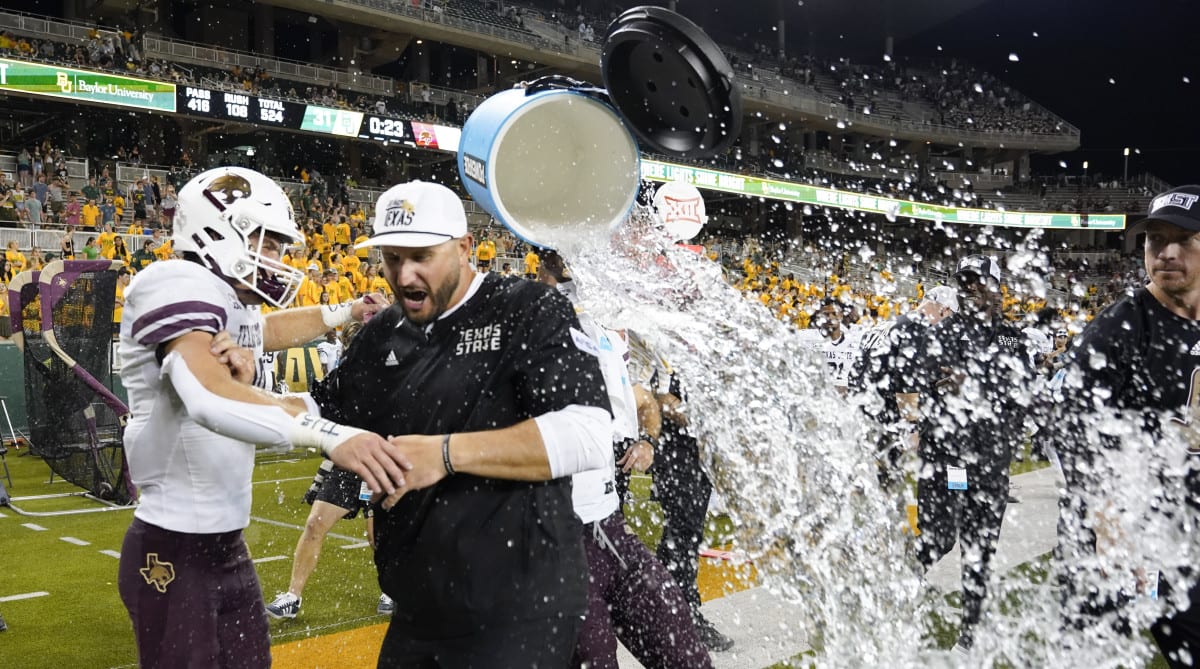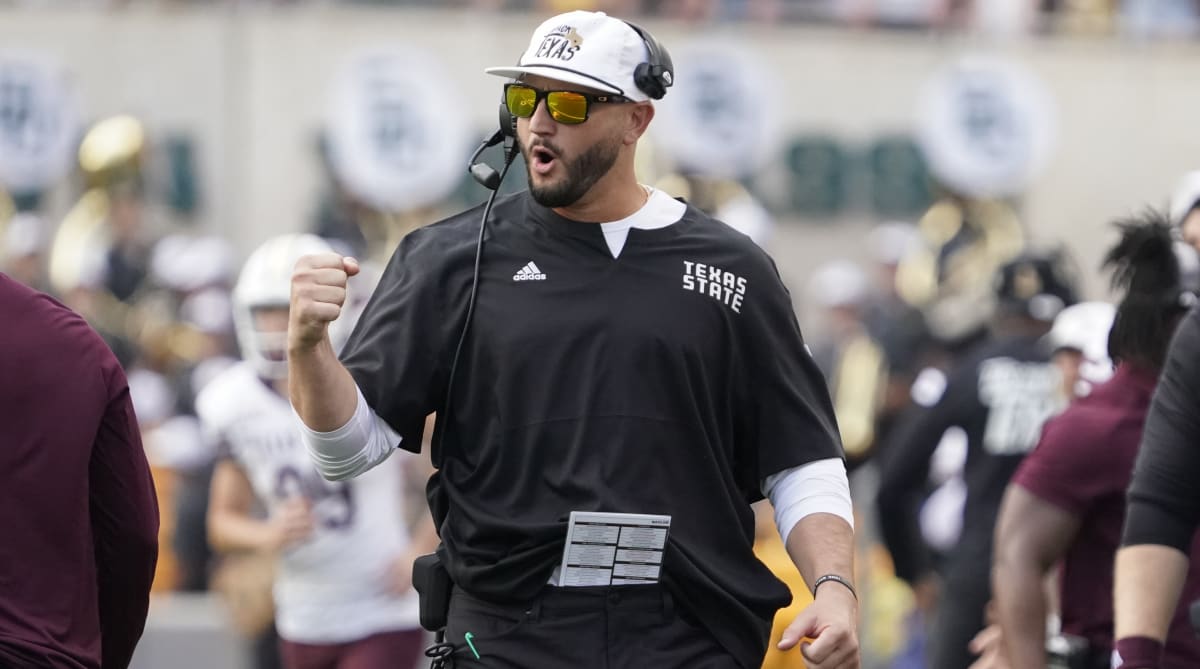When it comes to transfer portal roster turnovers in Year 1, Colorado has gotten all the headlines. It was Deion Sanders who said he was bringing Louis Vuitton luggage with him to Boulder and that he couldn’t put new furniture in his house without removing the old stuff in regards to a roster restock. It’s worked for CU, which has started the season 2–0.
But the second-most dramatic transfer portal overhaul this season is in San Marcos, Texas, halfway between Austin and San Antonio, where Texas State and first-year head coach G.J. Kinne took 39 players from the transfer portal and 14 from high school to make for 53 scholarship newcomers (over half the 85 scholarship limit). It may not be Colorado-level in notoriety, but the Bobcats did produce a similarly unlikely Week 1 result by stunning Baylor as a 27-point underdog to win convincingly.
The Texas State story is one of a native son coming home. Kinne grew up the son of a high school coach in east Texas and played at Gilmer High School before going to the University of Texas and eventually transferring to Tulsa and playing for Gus Malzahn. He bounced around the NFL and the CFL before starting his coaching career, which culminated in 2022 with his first head coaching job at FCS Incarnate Word. In just one season, the Cardinals reached the FCS semifinals before losing to power North Dakota State. Kinne flew from Fargo to his new job in San Marcos to begin assembling a roster. He didn’t have much time, and he didn’t have many players either, as the early signing period neared at the end of December.
“I just wanted the job so bad,” Kinne says. “I wasn’t doing a deep dive of their roster, to be honest with you. You know, I’m very confident in my abilities to coach and then—hey, you know, basically, we’ll figure it out.”
He had to sort through a unique situation. While coaching his Incarnate Word team through the playoffs, players who had contributed heavily for the previous staff at Texas State were leaving through the portal, which is a plight common for many Group of 5 programs. In all, 23 players transferred out.

Raymond Carlin III/USA TODAY Sports
There were hard conversations with some players who didn’t fit what Texas State needed, and an NCAA rule does allow new coaches to cut players from the team while still keeping them on an academic scholarship. Kinne says he felt a responsibility to do right by players he was inheriting from the previous staff that had already transferred once, as it was becoming clear that undergraduate transfers weren’t going to be granted waivers to transfer multiple times anymore.
But Kinne’s new staff likely could have used others who transferred out. DB DeJordan Mask went to play for Kinne’s old coach, Gus Malzahn, at UCF. Defensive lineman Davon Sears went to Oklahoma. Cornerback Jarron Morris went to FAU. Guard Kyle Hergel went to Boston College. Offensive lineman Dalton Cooper went to Oklahoma State, where he started in Week 2. But Kinne also inherited a program that did not feature a significant foundation of developmental bodies because the previous staff had all but eschewed high school recruiting in lieu of taking junior college and transfer players, most notably in 2021 when Texas State did not sign a single high school player in its December or February signing classes. While Colorado’s portal turnover was largely by choice, Texas State’s was by necessity.
Kinne didn’t come in with a plan to portal up quickly—he had holes to fill. There’s a notion that Sanders will spawn copycats who will have to come equipped with their roster turnover plan to interview for jobs this upcoming cycle, but multiple agents told Sports Illustrated they aren’t instructing their clients to take that approach. Rather, they should treat each job on a case-by-case basis as far a large-scale overhaul is concerned, although many acknowledge that around a 20% roster turnover rate is probably the norm moving forward in college football.
Texas State hadn’t had a coach with deep Texas high school football ties since 2015. While the influence of high school coaches can be overstated in many states, everyone understands you have to kiss the ring in Texas, and in some ways it can be foolish not to in such a talent-rich state, especially if you aren’t at a school that can recruit nationally like Texas or Texas A&M. Kinne says the plan is to sign around 15 high school players moving forward.
“I think there’s something to be said for signing the high school kid and developing him from Texas—it just matters,” Kinne says. “Some kid from New Jersey or some kid from Michigan, it’s just different. Texas State is not going to be mean as much as it will to a kid that’s from Austin or San Antonio.”
Many of the transfers he brought in have Texas ties. Kinne joked that when he loads up the portal to see who’s in it the first thing he does is filter by state so he can see which players are from Texas. Four of Texas State’s five offensive line starters came with Kinne from Incarnate Word. The fifth, Brey Walker, hails from just outside Norman in bordering Oklahoma. Out of the Bobcats’ main contributors so far this season on offense: Receiver Drew Donley and tight end Konner Fox are from Texas originally. Wideout Cole Wilson came from Incarnate Word and running back Ismail Mahdi played in-state at FCS Houston Christian. But getting his starting quarterback, former Auburn and LSU QB T.J. Finley, to transfer in required a little bit of a different tact and a cold call because the Louisianan didn’t have any significant ties.
“I was out in New Braunfels, kind of a date night, and you know, I’d had some liquid courage,” Kinne says. “I had [Finley’s] number and called him and just gave it to him straight. I think he got kind of got fired up after that call, to be honest with you. He had a couple other P5 visits lined up. And I was able to say ‘I want you to come to us first, when can you get here?’ This was Sunday. He said, ‘I can be there on Wednesday.’ So we got him here on a Wednesday, and I knew that was key to getting him.
“I pretty much kind of told him like, I see where things went wrong [at] LSU, I can see where things went wrong at Auburn, you know, both of the guys that really recruited you left, so you're with new guys that didn't recruit you and that can happen sometimes. So I think he appreciated the honesty. I think he appreciated the research that I did.”
It may seem like a given to do your homework on a player but it is an oft-underrated skill of scouting football players. Kinne’s multiple stops before becoming a head coach included a role with the Philadelphia Eagles in which he initially worked directly with general manager Howie Roseman, writing scouting reports on Arkansas and SMU players because he’d previously worked there. He also worked with legendary Eagles offensive line coach Jeff Stoutland as an offensive assistant, which fostered a “passion” for the evaluation process.
Stoutland is renowned for his adherence to critical factors he looks for in every player and his attention to detail. It helped the Eagles identify players like Jordan Mailata, a former rugby player, in the sixth round and Jason Kelce, the perennial all-pro center, also in the sixth. It also helped in evaluating future Hall of Famer Lane Johnson, who was seen as a reach when the team selected with the fourth pick in 2013. Johnson and Kinne are close friends, and the Bobcats head coach credits both of his stints as a player and a staffer in Philadelphia as exposing him to high-level athletes who were relative diamonds in the rough.

Raymond Carlin III/USA TODAY Sports
“I’m doing Google searches on every kid, I’m doing deep Twitter searches on every kid on Instagram, Twitter, I’m doing everything I possibly can and talking to as many coaches. That’s one thing about me . . . being in different spots and being in the NFL and being a college like different schools . . . I tend to know someone on staff and I tend to know if I trust this guy or I don’t trust this guy,” Kinne says. “We’re always calling multiple people and, and sometimes, you know, people will tell you the truth and sometimes you have to filter stuff out. Like, can you really play? I think that’s the hardest thing in the portal to figure out . . . is this kid getting run off because he’s really not good? Or is this kid just not a good system fit for them? Is this kid just a ‘he can’t play at OU, but he can play at Texas State?’”
The rise of digital tools like Pro Football Focus and HUDL may make unearthing under-the-radar players difficult, but particularly if you are taking a bevy of portal players, careful evaluation is key. Kinne believes strongly in traits, and you can see it in some of the lanky 6' 7" linemen the Bobcats have who rival the size of many more well-resourced Power 5 schools, including the Baylor team they were clearly bigger than in the Week 1 win. Kinne and his coaching staff are intensely hands-on in the evaluation process, and as the rise of personnel departments are starting to proliferate at the P5 level, Kinne’s a little reluctant to cede evaluation responsibilities to other members of his staff. It’s helpful to be at Texas State and not Texas or Texas A&M, where he might have the ability and the pressure to hire an army of support staffers. His resources are better than when he was at the FCS level and had to use other schools’ logins because they couldn’t afford a PFF subscription.
Kinne’s luggage might not be Louis, but it’s good enough to notch the first Power 5 win in program history, and for a Texas State program that’s had one winning season since coming up to FBS in 2012, they’ll take someone who can fix up the place any way they can get it.







